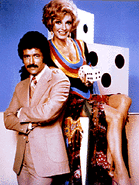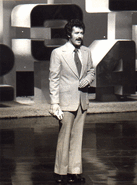| Aired | |
| NBC Daytime, Monday July 1, 1974-Friday June 11, 1976 Syndicated, September 8, 1975-September 19, 1976 | |
| Run time | |
| 30 Minutes | |
| Host | |
| Alex Trebek | |
| Announcer | |
| Kenny Williams | |
| Origination | |
| NBC Studio 2, Burbank, California | |
High Rollers is a game show inspired by the board game Shut the Box where "Every decision is a gamble and every move could be your last".
Game Format[]
Main Game[]
Two contestants competed, one of whom was a returning champion (or designate, if a previous champion had just retired). The object of the game was to remove numbers off a game board containing the digits 1 through 9 by having the hostess roll an oversized pair of dice. As mentioned above, High Rollers was modeled on a traditional board game called Shut the Box.
In order to determine who gained control of the dice, the host asked a toss-up question with either multiple-choice answers, true/false answers, or "Yes" or "No" answers; whoever buzzed in with the correct answer won control; an incorrect answer gave the opponent control. The player in control could either have the hostess roll the dice for themselves, an option usually taken only early in a game, or for his or her opponent to. This was by far the most common decision, especially as a game progressed, with fewer good rolls on the board (and since a bad roll automatically lost the game). However, if the odds of making a bad roll were low, such as a 3 or an 11, the player who won control of the dice could take the gamble.
Players removed numbers from the board based on the value of the roll of the dice (either all by itself or in combinations). For example, if a 10 was rolled, the player could remove any of these combinations: 1-9, 2-8, 3-7, 4-6, 1-2-7, 1-3-6, 1-4-5, 2-3-5 or 1-2-3-4, which were all combinations that added up to 10.
There was a prize hidden under every digit on the game board, revealed once that digit was eliminated; that prize was then added to the bank of the player who revealed it. Two digits each contained one half of a large prize, usually a new car or boat, or even a luxury vacation. To bank this prize, both "½" cards had to be uncovered by the same contestant. If the contestants each revealed one of the two cards, the prize was taken out of play.
Also, the potential numbers to be knocked off flashed accordingly, in groups of the added numbers.
Play continued until a bad roll, meaning no combination of digits currently on the board could match that roll of the dice, or the hostess took the last remaining digit(s) off the board (the rarer outcome).
The winner of the game kept any and all prizes in his/her bank; in the event the bank was empty, he/she won a "house minimum" of $100. The first player to win two games won the match.
"Face Lifters"[]
During the final seven weeks of this version (April 26 – June 11, 1976), the digits were arranged in a 3×3 grid, concealing a picture of a famous person and the contestant won the game for correctly identifying the person in the picture. A player could take a guess after a good roll. If there was a bad roll, the opponent was allowed one guess for each remaining number in the picture; a successful guess won the game plus the prizes belonging to the numbers still on the board. If neither player guessed who it was, Trebek gave clues until one player buzzed in with the answer.
The Big Numbers[]
In the bonus game, called the "Big Numbers", the hostess attempted to knock off numbers on a new, bigger gameboard. Insurance markers were awarded for doubles, the only time they factored into the gameplay.
In the early episodes, players had an opportunity to stop and take $100 per good roll. If they held an insurance marker, the hostess could roll again after making a bad roll. However, a bad roll without insurance markers not only ended the game, but the player also would lose all the money accumulated. If the hostess cleared eight numbers, the player won a new car; if the board was cleared, they also won $10,000 ($5,000 during the first week). The rules soon changed so that Big Numbers was played for a flat $10,000, with a Big Numbers loss awarding $100 for each number eliminated.
Syndicated Version[]
Airing weekly from 1975 to 1976, this had almost identical rules. The only major difference, besides more expensive prizes being offered, was that the same two players competed for the entire show. After the first few episodes of this version, the rules were changed so that, rather than requiring players to win a best-of-three match, the winner of each game played "The Big Numbers". Once "The Big Numbers" were played (for $10,000), the losing player was brought back out for another game. The players played as many games as possible until time was called. If time was called during a game, the one who knocked the most numbers out won that game, their prizes (or the $100), and (in the best-of-three episodes) played "The Big Numbers" for (another) $10,000. Thus, a player could win over $30,000 in a single show. However, like other weekly nighttime game shows at that time, this version had no returning champions.
Except the syndicated version, players could stay until they lost or won five matches.
| This page uses Creative Commons Licensed content from Wikipedia (view authors). |
Trivia[]
This was the one and only version that mainly had the female co-host/models (i.e. Ruta Lee and Elaine Stewart respectively) act as dice rollers for the contestant instead of rolling the dice for themselves.
This was the one and only version where the contestants sat along the long side of the dice table opposite from Trebek.
International Versions[]
Main Article: High Rollers/International
Merchandise[]
Board Games[]
E.S. Lowe/Milton Bradley (1975)
Photos[]
Episode Status[]
International[]
See Also[]
High Rollers (1978)
Lucky Numbers
High Rollers (1987)

















